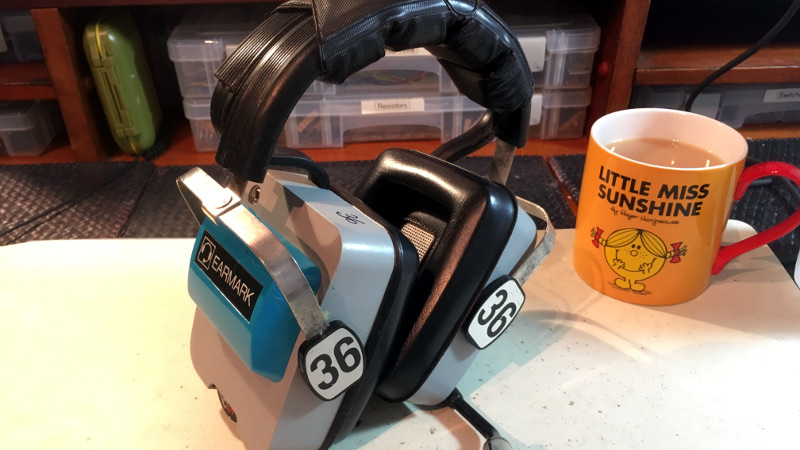We will have all picked up something from a junk pile or swap meet in our time that caught our eye not because we needed it but because it looked cool. [Quinn Dunki] did just that with an irresistible set of 1980s air traffic control headphones. What did she do with them? Turn them into a set of Bluetooth headphones of course!
The ‘phones in question are particularly interesting, as they turned out upon inspection to be a two-way radio in disguise. Cracking them open revealed a radio board and a logic board, and what makes them particularly interesting to this Hackaday scribe’s eye is their choice of frequency. She finds a crystal with a VHF airband frequency multiplier and concludes that they must operate there, but a look at the photos reveals all the ingredients of a classic AM or low HF receiver. There is a ferrite rod antenna and a variable capacitor, if we didn’t know that these were very high-end professional ‘phones we’d almost suspect they were a novelty AM radio from Radio Shack. If any readers can shed any light on the frequency and purpose of this device, we’re all ears.
The conversion involved a Sparkfun Bluetooth module breakout board paired with a little audio power amplifier. The original drivers were high-impedance and one of them had died, so she replaced them with a modern pair of identical size. The control buttons were mounted in the headphone’s external housing, after a wrong turn into attempting to create a custom enclosure. The result is a rather novel but high-quality set of ‘phones, and one we rather wish we’d found ourselves.
















However the cat photo made the story all the more better to read.
Yes, cats are always good.
Also when I saw this “little miss sunshine” coffee mug in the picture, I first started to think “what childish junk”. But when I looked down on the lovely face smiling from one ear to the other, I could just not help myself from smiling. :-)
“… we’re all ears.”, really? Really?
You were close with the comment about air traffic control.
They’re ground crew transceivers and the size of the channel indicator (number 36) gives away their purpose.
The number is too small to be seen by a controller on a commercial airfield because a commercial airfield is just too large.
They are working in a military band. They look like they are used on an aircraft carrier where the ground crew are in clear view of the command tower.
The number 2180 is actually 2 / 80 and is the last calibration date – February 1980
Look like this two way was like the first gen cordless phones, FM on HF (AM band) and FM on VHF. Easy way to not cause crosstalk in those days. Those little tiny drivers as well as blurtooth wouldn’t be worth a listen for me. Save your hearing for real sound. Blurtooth in an ATC situation would not be acceptable because of the delay. Don’t use it when calling anyone please.
Decades ago we once had such a cordless phone, I nearly could not believe the way-different bands: like 1,7MHz and 40.xx MHz. My father bought it at the airport in America. And it was the tiniest cordless phone I had seen at that time: A flip phone which worked with a 3,6V/100mAh battery for a longer time than the official cordless phones at that time available here.
Of course it was not licensed for use in Europe, especially at this time telephony was completely in official hands of the post offices and the equipment was owned and handed out by them. For “quarter line” phones they did not allow (hand out) cordless phones anyway.
But it worked. At least for receiving calls. For outgoing calls you had to press the button on the official phone, than you could take over.
I am not sure , if the small delay of Bluetooth would really a problem. Some time in the early 2000s I worked in a small electronics company and a customer (a company which develops and sells ATC communication technology and equipment all over the whole world) wanted to construct a BT cordless headset systems for the air traffic controllers in the tower.
It did not work out at the end, but not because of delay. The problem was the channel capacity of parallel operation. They wanted to be able to operate dozens of two way (and stereo) head set links in parallel in the same room. Basically they wanted (hoped) to get much more parallel channels than with DECT, but it was way below any theoretical calculation that crackling, noise and interruptions occurred, due to the unpredictable frequency hopping of the single BT links.
This is a great idea. I bought a few headphones that looked similar to this at a thrift store years ago but haven’t done anything with them since.
Cool article! It worth the reading specially for mentioning the things that went wrong along the way.
Wouldn’t the 2180 be a date code ( 2/80 ) instead of frequency? And the detents in dial might be useful to avoid the dial to slip accidentally instead of marking a fixed channel .
In regards to the damaged Bluetooth module,
Maybe it could be recovered by eroding back a bit of the PCB with a Dremel Tool (As Seen on HackADay! TM)
and soldering to whatever metal that gets exposed.
I remember reading an article about hacking a FM radio to receive air traffic eons ago. I had to stretch some of the coils for to reach above the FM dial and detune the IF can to fool it into demodulating the AM signal. It worked, but as a teen I lost interest in it rather quickly.